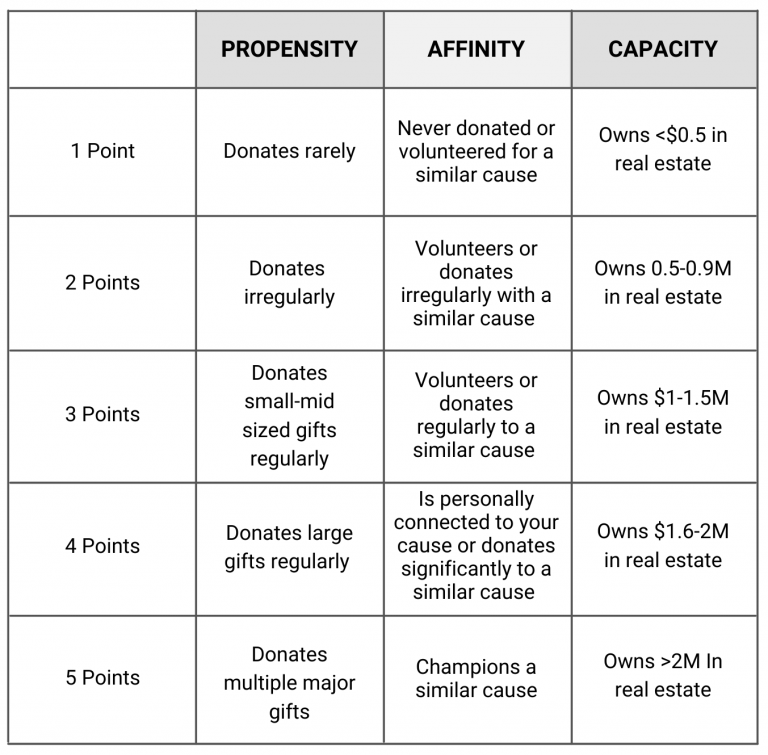While vital to the continued success of any nonprofit, finding new, passionate, and capable donors can be quite the challenge. To perform prospect research properly, fundraisers need to align their strategy with their mission, fully command their databases, and access the right tools.
With all of these factors to consider, fundraisers have to design a comprehensive prospect research plan to remain organized and set themselves up for success.
5 Steps to Creating a Comprehensive Prospect Research Plan
1. Set Your Goals
Before looking for prospects, you need to clearly articulate what type of prospect you’re looking for. Monthly giving prospects, planned giving prospects, annual giving prospects, and major gifts prospects, to name a few, will all have different demographic and behavioral indicators signaling their suitability for a specific campaign/fund type.
For example, when looking for monthly giving prospects, you would focus on donors who recently gave to your organization. However, you would primarily study wealth and philanthropic indicators such as political campaign contributions for major giving. So, to have a successful prospect research strategy, you need to have a focused solicitation plan first.
Additionally, align your strategy with your mission and organizational needs. For example, if a few major donors support your organization, it may be time to focus on developing your monthly giving program to promote financial stability. Similarly, if your organization is looking to invest in a new facility, you’ll need to identify major donors who will support a capital campaign.
Lastly, to keep prospecting on track, make sure someone is responsible for tracking your goals. This person should ensure you reach your prospect identification quotas, flag any issues, and create a concrete timeline for the entire process.
2. Clean Your Data
It’s hard to find your favorite shirt if your closet is a mess. Similarly, it’s challenging to accurately identify prospects with a messy data set. This is why it’s so important to clean your data when identifying prospects.
Essentially, data cleaning is the process of organizing your data that involves removing inactive contacts from your database, merging duplicate profiles, and updating contact information.
Manually cleaning your database could take hours, if not days, to complete. This is why it’s so important to get a customer relationship management system (CRM) that does most of the cleaning for you.
With a CRM like Keela, duplicate profiles are automatically detected, inactive contacts can be segmented and removed, and profiles are automatically updated with their latest transactions.
Best of all, with a CRM that takes the administrative work out of data management, prospect research takes a fraction of the time.
3 Factors to Evaluate Your Nonprofit’s Prospects
All prospect researchers should measure three factors to evaluate and rank prospects: propensity, affinity, and capacity.
- Propensity: A prospect’s general inclination to give philanthropically. You can determine propensity by identifying a prospect’s previous donation history. If there’s no record of a prospect making a previous donation, they likely aren’t going to be a strong prospect even if they have all the money in the world.
- Affinity: A prospect’s linkage to your cause. Affinity can be measured by researching donations a prospect has made to similar causes or by tracking social connections between your stakeholders and the prospect.
- Capacity: A prospect’s ability to give. Researchers can measure capacity by identifying wealth indicators such as real estate ownership. We’ll talk more about wealth screening below!
By measuring these factors, researchers can identify and rank prospects to streamline their solicitations.
Get Timely, Actionable Donor Insights with Fundraising KIT
Fundraising KIT helps you uncover patterns and trends in your donor data. It keeps you abreast of any changes in your donor behavior so you can adjust your strategy and stay on track to meet your goals.
3. Analyze Your Data
Now that you have a clear plan and data to work with, it’s time to identify some prospects!
The most efficient way to identify quality prospects is by using a wealth screening tool. Tools like iWave, DonorSearch, and Windfall rely on their massive philanthropic database to find perfect prospects for your organization.
For example, Windfall provides precise net worth calculations, so fundraisers have a clear understanding of the giving capacity of a particular prospect. Additionally, Windfall outlines personal and household attributes to give users a deeper understanding of their contacts.
What makes tools like Windfall so powerful is that they search their own databases for ideal donors and enrich your data to highlight the giving potential of prospects that you may not have been aware of before.
While you could do all of the research manually, finding a prospect or donor research tool to do the work for you is far less time-consuming and resource-intensive.
Although these tools can do all of the work for you, it’s still good to understand some of the indicators of a grade-A prospect. Here’s a list of indicators for planned giving, monthly giving, and major donors:
1. Planned Giving Indicators: Donor demographics and behaviors that signal the potential of a legacy gift (a donation outlined in a donor’s will).
A. Donor Loyalty: 50% of legacy donors give to their organization for more than 20 years before leaving behind a planned gift
B. Age: Donors age 44 and older represent more than 75% of all wills and more than 80% of the total value of all charitable bequests made
C. Parental Status: Among donors age 50 and over with no children, 50% had charitable estate plans. Among similar donors with children, only 17% had charitable plans.
D. Marital Status: Planned gifts from single, never married donors are about 13% larger than married donors
E. Pet Ownership: Pet owners are about 70% more likely to give! In addition, while pet owners write only 25% of all wills, 70% of these wills include a charitable bequest.
2. Monthly Giving Indicators: Donor behaviors that signal the potential of recurring monthly gifts.
A. Gift Recency: Regular donors who’ve made two or more gifts in the last six months are more likely to commit to monthly giving than those who haven’t.
B. Age: 60% of Millennials are interested in monthly giving. Even better, 45% of millennials have already given online, indicating the comfortability with virtual giving technologies required for monthly giving.
3. Major Gifts Indicators: Donor demographics and behaviors that signal the potential of a gift that would be among the largest your organization receives.
A. Real Estate Ownership: A prospect who owns $2M+ of real estate is 17 times more likely to give philanthropically than the average person.
B. Political Campaign Contributions: A prospect who’s given at least $2,500 to federal political campaigns is about 14 times more likely to donate than someone who hasn’t.
C. Previous Nonprofit Donations: Prospects who’ve made a gift of over $100k to a nonprofit are 32 times more likely to donate elsewhere.
4. Rank Your Prospects
Most CRMs and prospect research tools will automatically rank prospects to prioritize donors who are more likely to give and give large gifts. However, you can also rank prospects manually by grading how well they score in the categories of propensity, affinity, and capacity.
Each organization will have different standards and will grade these metrics accordingly, but an example of a grading rubric looks something like this:

In this example, prospects can receive as few as 3 points and as much as 15 points, with 15 points being the best possible prospect.
If a prospect donates large gifts regularly, donates irregularly to a similar cause, and owns a $3M house, they would receive a score of 11. A score of 11/15 is excellent, and this prospect should be a priority for future appeals.
The above table only lists a few behaviors and demographics that should be tracked within each of the three categories. So, when ranking your own prospects, consider all of the elements that could indicate a prospect’s propensity, affinity, and capacity.
Start Segmenting Your Donors
Use this FREE Donor Segmentation Template to segment your donors and contacts based on their level of engagement.
5. Make Your Appeals
With your prospects ranked, it’s time to reach out to the donors who could make a significant difference to your nonprofit organization. When preparing your appeals, don’t forget what you learned from your research!
Consider paying closer attention to these factors before you make an ask:
- Gift Size: When considering how much to ask for, look at a prospect’s first donation to a similar organization. Be careful not to model your ask after a donor’s later contributions, as they may not represent what they’re willing to give to your organization initially.
- Campaign/Fund Type: Also, pay attention to what their money went towards. Did they donate towards a new wing of a building? Was their donation restricted to a specific program? Did they launch a matching campaign? Fundraisers should ask themselves questions like these to strategically align themselves with a donor.
- Time of Year: Take a look at when a prospect tends to give. By reviewing prospects’ giving histories, you may find a pattern in when they prefer to give. If you find a particular time they like to donate, plan your appeal with that date in mind.
There are a variety of factors to pay attention to when preparing for your appeal. The more research you do leading up to an ask, the better you’ll be able to connect donors to your organization’s mission.
By following these five steps, fundraisers are not only increasing the quality of their prospects and likely their organization’s revenue, they are also providing prospective donors with an opportunity to give in a more meaningful way.
By studying prospects’ motivations and histories, fundraisers can present prospects with a philanthropic strategy tailored to their interests, providing a deeper level of meaningfulness to their giving.

Jack Showers
Nonprofit Research Analyst at Fundraising KIT
When Jack isn’t cheering for the Raptors or watching an 80s action movie, he’s studying the social sector and producing content for nonprofit professionals. As a Nonprofit Research Analyst at KIT, an AI-powered insights and reporting toolkit, he is especially passionate about helping fundraisers save time and raise more money for their cause.







